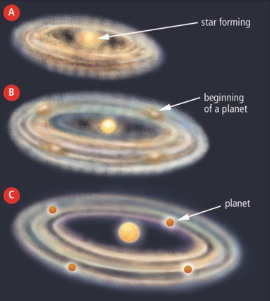the sun and its planetary system
sun is the centre of our solar system
solar system full of planets, moons, asteroids, and comets
all revolve around the sun at the centre
when a star forms from a nebula, gravity pulls most of the material into the new star, some may also clump together to form objects in a solar system
planet - celestial body that orbits one or more stars
each planet may also spin on its axis as it orbits the sun

planet requirements
celestial body must orbit one or more stars, be large enough that its own gravity holds it in a spherical shape, and be the only body occupying the orbital path
order
-
sun, mercury, venus, earth, mars, jupiter, saturn, uranus, neptune
solar system formed 4.5+ billion years ago
after the sun formed, material closest to the sun developed into inner/terrestrial planets
small, solid cores, rocky crusts
mercury, venus, earth, mars
material further from the sun developed into the outer/Jovian planets
large gaseous bands, cold temperatures
jupiter, saturn, uranus, neptune
distance between planets in solar system measured in astronomical units (AU)
one AU = average distance from sun to earth
inner planets relatively close to centre of the solar system
mars is 1.52 au from sun, vs jupiter is 5.27 au from the sun
neptune is 30.06 au from sun
rotation
motion of earth as it spins on its axis from west to east
spins on axis at 1670km/hr (one full rotation takes almost a day)
revolution
motion of earth as it orbits usn
orbits sun at 30km/sec - one full revolution takes almost a year
sun
contains more than 99% of mass in solar system
composed of mainly hydrogen gas
nuclear reactions in the sun’s core causes hydrogen to form helium
energy is radiated to earth, keeping it warm enough to support life
solar wind
sometimes gases from sun erupt outwards like bursting soap bubble
resulting solar wind is full of high energy particles that would kill any life on earth they struck
our magnetic field deflects this solar wind
see the deflection when we see the northern lights
asteroid - small leftover remains from the formation of the solar system
thousands of asteroids orbit in the asteroid belt between mars and jupiter
comet - composed of ice, rock, and gas (dirty snowballs)
leaves trail of gas and dust when in contact with sunlight
other solar system bodies
bodies smaller than planets in our solar system
moons found around all planets except mercury and venus
asteroids found mainly between mars and jupiter in the asteroid belt
thought these are the leftovers from the formation of the solar system
comets are rocky travelers - following orbits faroutside planets in the oort cloud
oort cloud - at farthest reach of the sun’s gravitational pull, almost 25% of way to next nearest star, proxima centauri
trans-neptunian objects
beyond neptune
compoesd of fragments of material left over from formation of the solar system
these objects orbit the sun in a larger area known as the kuiper belt
pluto is a dwarf planet
why is pluto no longer a planet [video]
pluto hasn’t been a planet since 2006
demoted at the 26th general assembly of international astronomical union in prague (2006)
only argument for keeping it was “tradition” - no scientific justification for calling pluto a planet
it’s out in kuiper belt - asteroid belt past neptune - trillion things in belt
nearly all are chunks of ice and rock like pluto, we just discovered pluto first
pluto isn’t even biggest , eries - 25% bigger by mass than pluto
haumea, makemake, ceres
up to 100 big things in kuiper belt
downgrade because so many big planets
planet would stop being useful as a term
new criteria : orbit sun, have enough gravity to pull itself into spherical shape, clear everything out of mass
only 0.07 times mass of everything in orbit vs earth is 1.7mil times
dwarf planets follow only the first two criteria
dwarf planets past neptune called plutoids
new horizons spacecraft will go past pluto in 2015